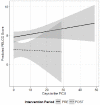Goal-Directed Resuscitative Interventions During Pediatric Interfacility Transport
- PMID: 25860203
- PMCID: PMC4506208
- DOI: 10.1097/CCM.0000000000001021
Goal-Directed Resuscitative Interventions During Pediatric Interfacility Transport
Abstract
Objectives: This article reports results of the first National Institutes of Health-funded prospective interfacility transport study to determine the effect of goal-directed therapy administered by a specialized pediatric team to critically ill children with the systemic inflammatory response syndrome. We hypothesized that goal-directed therapy during interfacility transport would decrease hospital length of stay, prevent multiple organ dysfunction, and reduce subsequent ICU interventions.
Design: Before-and-after intervention trial.
Setting: During interfacility transport of critically ill patients by a specialized pediatric transport team, back to a tertiary care children's hospital.
Patients: Before-and-after intervention trial.
Design: Interfacility pediatric transport patients, age 1 month to 17 years, with systemic inflammatory response syndrome.
Interventions: Prospective data were collected on all pediatric interfacility transport patients with systemic inflammatory response syndrome transported by the Angel One Transport team at Arkansas Children's Hospital. A 10-month data collection period was followed by institution of a goal-directed resuscitation protocol. Data were subsequently collected for 10 additional months followed by comparison of pre- and postintervention groups. All transport personnel underwent training with didactics and high-fidelity simulation until mastery with goal-directed resuscitation was achieved.
Measurements and main results: All transport patients were screened for systemic inflammatory response syndrome using established variables and 235 (123 preintervention and 112 postintervention) were enrolled. Univariate analysis revealed shorter hospital stay (11 ± 15 d vs 7 ± 10 d; p = 0.02) and fewer required therapeutic ICU interventions in the postintervention group (Therapeutic Intervention Scoring System-28 Scores, 19.4 ± 6.8 vs 17.3 ± 6.6; p = 0.04). ICU stay and prevalence of organ dysfunction were not statistically different. Multivariable analysis showed a 1.6-day (95% CI, 1.3-2.03; p = 0.02) decrease in hospital stay in the postintervention group.
Conclusions: This study suggests that goal-directed therapy administered by a specialized pediatric transport team has the potential to impact the outcomes of critically ill children. Findings from this study should be confirmed across multiple institutions, but have the potential to impact the clinical outcomes of critically ill children with systemic inflammatory response syndrome.
Trial registration: ClinicalTrials.gov NCT01293500.
Figures
References
-
- Orr RA, Felmet KA, Han Y, et al. Pediatric specialized transport teams are associated with improved outcomes. Pediatrics. 2009;124(1):40–8. - PubMed
-
- Stroud MH, Trautman MS, Meyer K, et al. Pediatric and neonatal interfacility transport: results from a national consensus conference. Pediatrics. 2013;132(2):359–66. - PubMed
-
- Stroud MH, Prodhan P, Moss M, Fiser R, Schexnayder S, Anand K. Enhanced monitoring improves pediatric transport outcomes: a randomized controlled trial. Pediatrics. 2011;127(1):42–8. - PubMed
-
- Rivers E, Nguyen B, Havstad S, et al. Early goal-directed therapy in the treatment of severe sepsis and septic shock. N Engl J Med. 2001;345:1368–77. - PubMed
Publication types
MeSH terms
Associated data
Grants and funding
LinkOut - more resources
Full Text Sources
Medical




